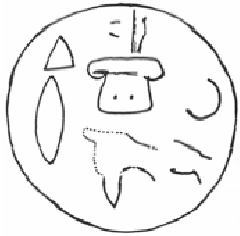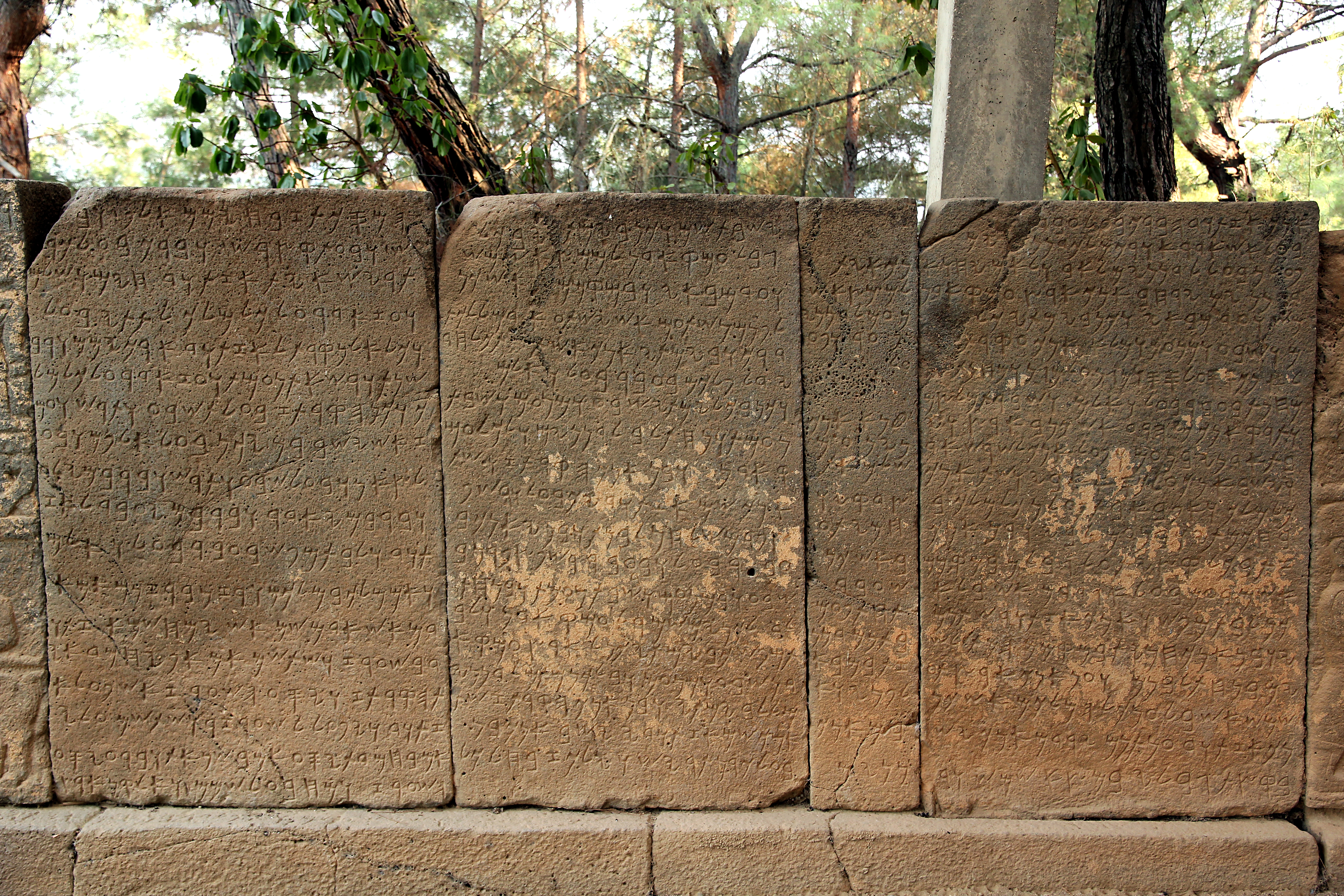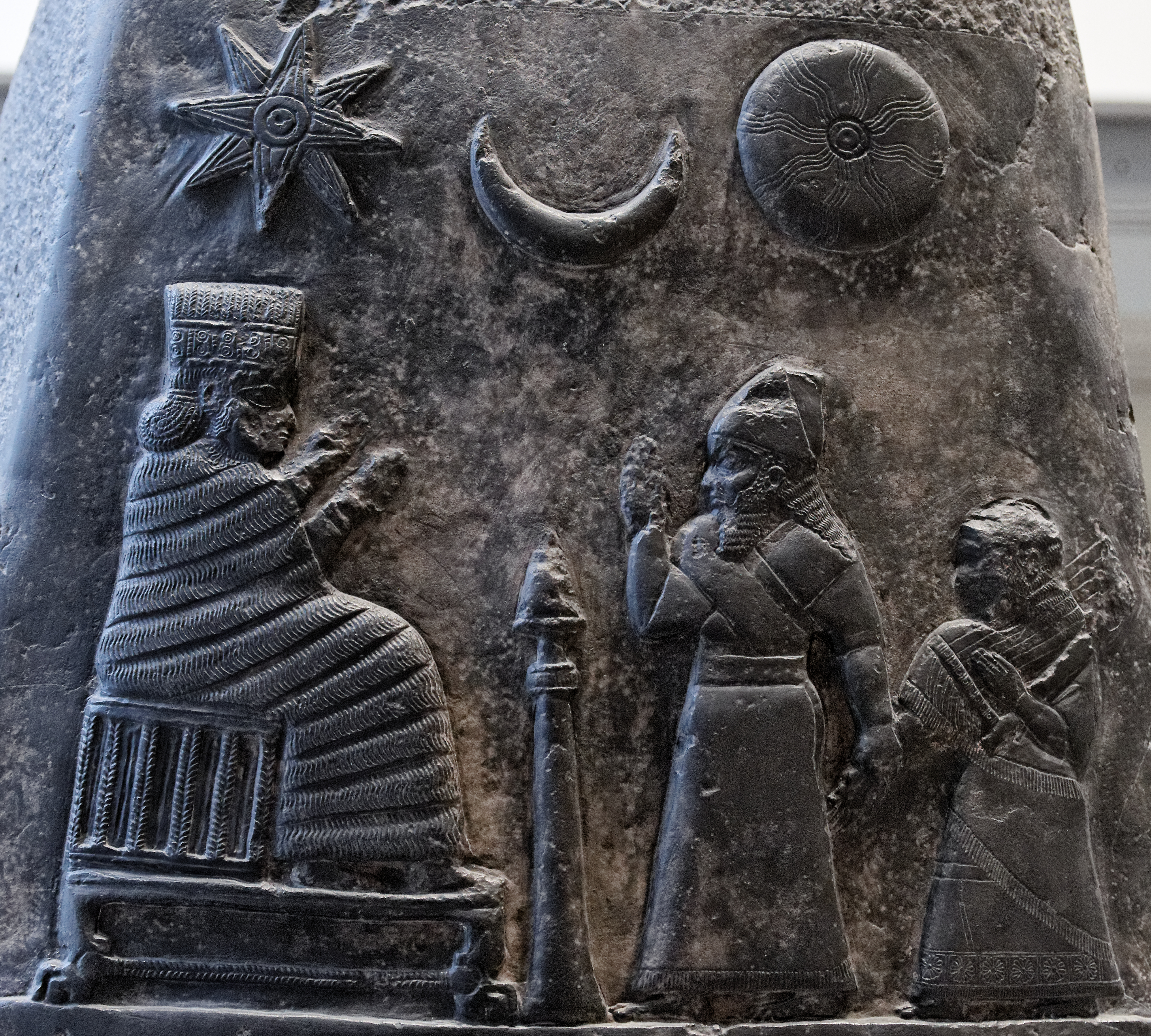|
Saggar (god)
Saggar (also Šaggar, Sanugaru, Šanugaru) was a god worshiped in ancient Syria, especially in the proximity of Ebla and Emar, later incorporated into the Hurrian and Hittite pantheons. His name was also the ancient name of the Sinjar Mountains. It is assumed that he was at least in part a lunar deity. Character Information about the character and development of Saggar is incomplete and difficult to interpret. The name itself is not spelled consistently, especially in sources from the second millennium BCE, and in particular the first consonant often varies between ''s'' and ''š''. The meaning of the name is unknown, and it has been proposed that it comes from a linguistic substrate unrelated to other languages of the Ancient Near East. Two primary aspects of Saggar seemed to be those of a deified mountain range and of a lunar god. Deified mountain range The name Saggar was applied to a mountain range presumably associated with the god, located in the north of modern Iraq, kn ... [...More Info...] [...Related Items...] OR: [Wikipedia] [Google] [Baidu] |
Sinjar Mountains
The Sinjar Mountains (, , ), are a mountain range that runs east to west, rising above the surrounding alluvial steppe plains in northwestern Iraq to an elevation of . The highest segment of these mountains, about long, lies in the Nineveh Governorate. The western and lower segment of these mountains lies in Syria and is about long. The city of Sinjar is just south of the range.Edgell, H. S. 2006. ''Arabian Deserts: Nature, Origin, and Evolution.'' Springer, Dordrecht, The Netherlands. 592 pp. Numan, N. M. S., and N. K. AI-Azzawi. 2002. ''Progressive Versus Paroxysmal Alpine Folding in Sinjar Anticline Northwestern Iraq.'' Iraqi Journal of Earth Science. vol. 2, no.2, pp.59-69. These mountains are regarded as sacred by the Yazidis. Geology The Sinjar Mountains are a breached anticlinal structure. These mountains consist of an asymmetrical, doubly plunging anticline, which is called the "Sinjar Anticline", with a steep northern limb, gentle southern limb and a northerly ... [...More Info...] [...Related Items...] OR: [Wikipedia] [Google] [Baidu] |
Akkadian Language
Akkadian ( ; )John Huehnergard & Christopher Woods, "Akkadian and Eblaite", ''The Cambridge Encyclopedia of the World's Ancient Languages''. Ed. Roger D. Woodard (2004, Cambridge) Pages 218–280 was an East Semitic language that is attested in ancient Mesopotamia ( Akkad, Assyria, Isin, Larsa, Babylonia and perhaps Dilmun) from the mid- third millennium BC until its gradual replacement in common use by Old Aramaic among Assyrians and Babylonians from the 8th century BC. Akkadian, which is the earliest documented Semitic language, is named after the city of Akkad, a major centre of Mesopotamian civilization during the Akkadian Empire (–2154 BC). It was written using the cuneiform script, originally used for Sumerian, but also used to write multiple languages in the region including Eblaite, Hurrian, Elamite, Old Persian and Hittite. The influence of Sumerian on Akkadian went beyond just the cuneiform script; owing to their close proximity, a lengthy span of con ... [...More Info...] [...Related Items...] OR: [Wikipedia] [Google] [Baidu] |
An = Anum
''An = Anum'', also known as the Great God List, is the longest preserved Mesopotamian god list, a type of lexical list cataloging the deities worshiped in the Ancient Near East, chiefly in modern Iraq. While god lists are already known from the Early Dynastic period, ''An = Anum'' most likely was composed in the later Kassite period. While often mistakenly described as a list of Sumerian deities and their Akkadian equivalents, ''An = Anum'' is focused on presenting the familial relationships between deities, as well as their courts and spheres of influence. The first four tablets list the major gods and goddesses ( Anu, Enlil, Ninhursag, Enki, Sin, Shamash, Adad and Ishtar) and their courts, arranged according to theological principles, but tablets V and VI do not appear to follow a clear system, and tablet VII is a late appendix listing the names of Marduk and one of his courtiers. Many other works of ancient scholarship were influenced by ''An = Anum'', including a simil ... [...More Info...] [...Related Items...] OR: [Wikipedia] [Google] [Baidu] |
Ugarit
Ugarit (; , ''ủgrt'' /ʾUgarītu/) was an ancient port city in northern Syria about 10 kilometers north of modern Latakia. At its height it ruled an area roughly equivalent to the modern Latakia Governorate. It was discovered by accident in 1928 with the Ugaritic texts. Its ruins are often called Ras Shamra after the headland where they lie. History Ugarit saw its beginnings in the Neolithic period, the site was occupied from the end of the 8th millennium BC and continued as a settlement through the Chalcolithic and Bronze Ages. It was during the late bronze age that Ugarit experienced significant growth, culminating in the establishment of the Kingdom of Ugarit. The city had close connections to the Hittite Empire, in later times as a vassal, sent tribute to Ancient Egypt, Egypt at times, and maintained trade and diplomatic connections with Cyprus (then called Alashiya), documented in the archives recovered from the site and corroborated by Mycenaean Greece, Mycenaean and Cyp ... [...More Info...] [...Related Items...] OR: [Wikipedia] [Google] [Baidu] |
Anatolia
Anatolia (), also known as Asia Minor, is a peninsula in West Asia that makes up the majority of the land area of Turkey. It is the westernmost protrusion of Asia and is geographically bounded by the Mediterranean Sea to the south, the Aegean Sea to the west, the Turkish Straits to the northwest, and the Black Sea to the north. The eastern and southeastern limits have been expanded either to the entirety of Asiatic Turkey or to an imprecise line from the Black Sea to the Gulf of Alexandretta. Topographically, the Sea of Marmara connects the Black Sea with the Aegean Sea through the Bosporus and the Dardanelles, and separates Anatolia from Thrace in Southeast Europe. During the Neolithic, Anatolia was an early centre for the development of farming after it originated in the adjacent Fertile Crescent. Beginning around 9,000 years ago, there was a major migration of Anatolian Neolithic Farmers into Neolithic Europe, Europe, with their descendants coming to dominate the continent a ... [...More Info...] [...Related Items...] OR: [Wikipedia] [Google] [Baidu] |
Cuneiform
Cuneiform is a Logogram, logo-Syllabary, syllabic writing system that was used to write several languages of the Ancient Near East. The script was in active use from the early Bronze Age until the beginning of the Common Era. Cuneiform scripts are marked by and named for the characteristic wedge-shaped impressions (Latin: ) which form their Grapheme, signs. Cuneiform is the History of writing#Inventions of writing, earliest known writing system and was originally developed to write the Sumerian language of southern Mesopotamia (modern Iraq). Over the course of its history, cuneiform was adapted to write a number of languages in addition to Sumerian. Akkadian language, Akkadian texts are attested from the 24th century BC onward and make up the bulk of the cuneiform record. Akkadian cuneiform was itself adapted to write the Hittite language in the early second millennium BC. The other languages with significant cuneiform Text corpus, corpora are Eblaite language, Eblaite, Elamit ... [...More Info...] [...Related Items...] OR: [Wikipedia] [Google] [Baidu] |
Anatolian Hieroglyphs
Anatolian hieroglyphs are an indigenous logographic script native to central Anatolia, consisting of some 500 signs. They were once commonly known as Hittite hieroglyphs, but the language they encode proved to be Luwian language, Luwian, not Hittite language, Hittite, and the term Luwian hieroglyphs is used in English publications. They are typologically similar to Egyptian hieroglyphs, but do not derive graphically from that script, and they are not known to have played the sacred role of hieroglyphs in Egypt. There is no demonstrable connection to Hittite cuneiform. History Individual Anatolian hieroglyphs are attested from the second and early first millennia BC across Anatolia and into modern Syria. A biconvex bronze personal seal was found in the Late Bronze Age Troy, Troy VIIb level (later half of the 12th century BC) inscribed with Luwian Hieroglyphs. The earliest examples occur on personal Seal (emblem), seals, but these consist only of names, titles, and auspicious sign ... [...More Info...] [...Related Items...] OR: [Wikipedia] [Google] [Baidu] |
Yarikh
Yarikh (Ugaritic: , , "moon"), or Yaraḫum, was a moon god worshiped in the Ancient Near East. He is best attested in sources from the Amorite city of Ugarit in the north of modern Syria, where he was one of the principal deities. His primary cult center was most likely Larugadu, located further east in the proximity of Ebla. His mythic cult center is Abiluma. He is also attested in other areas inhabited by Amorites, for example in Mari, but also in Mesopotamia as far east as Eshnunna. In the Ugaritic texts, Yarikh appears both in strictly religious context, in rituals and offering lists, and in narrative compositions. He is the main character in ''The Marriage of Nikkal and Yarikh'', a myth possibly based on an earlier Hurrian composition. The eponymous goddess was regarded as his wife in Ugarit, but she is not attested in documents from most other Syrian cities, and most likely only entered the Ugaritic pantheon due to the influence of Hurrian religion. Ugarit ceased to exis ... [...More Info...] [...Related Items...] OR: [Wikipedia] [Google] [Baidu] |
Hadabal
Hadabal (also spelled 'Adabal) was a god worshiped in Ebla and its surroundings in the third millennium BCE. He was one of the main gods of that area, and appears frequently in Eblaite documents. His character is not well understood, though it has been proposed that he might have been an agricultural or lunar god. Like the city's tutelary god Kura and his wife Barama, he is absent from sources postdating the destruction of Ebla. Name and origin The name Hadabal was written as dNI-''da''-KUL or dNI-''da''-BAL in Eblaite cuneiform. The KUL sign being a simplified version of BAL, employed in texts later than the time of the vizier Arrukum. Alfonso Archi assumes that it belonged to a linguistic substrate, similar to these of other Eblaite gods, including Adamma, Aštabi, Išḫara and Kura. The existence of a non- Semitic and non-Hurrian substrate language in ancient Syria has been first proposed by Igor M. Diakonoff, who in 1971 concluded that Išḫara and Kubaba, while worshipe ... [...More Info...] [...Related Items...] OR: [Wikipedia] [Google] [Baidu] |
Sin (mythology)
Sin () or Suen (, ) also known as Nanna ( ) is the Mesopotamian god representing the moon. While these two names originate in two different languages, respectively Akkadian language, Akkadian and Sumerian language, Sumerian, they were already used interchangeably to refer to one deity in the Early Dynastic Period (Mesopotamia), Early Dynastic period. They were sometimes combined into the double name Nanna-Suen. A third well attested name is Dilimbabbar (). Additionally, the name of the moon god could be represented by logograms reflecting his lunar character, such as d30 (), referring to days in the lunar month or dU4.SAKAR (), derived from a term referring to the crescent. In addition to his astral role, Sin was also closely associated with cattle herding. Furthermore, there is some evidence that he could serve as a judge of the dead in the Ancient Mesopotamian underworld, underworld. A distinct tradition in which he was regarded either as a god of equal status as the usual hea ... [...More Info...] [...Related Items...] OR: [Wikipedia] [Google] [Baidu] |
New Moon
In astronomy, the new moon is the first lunar phase, when the Moon and Sun have the same ecliptic longitude. At this phase, the lunar disk is not visible to the naked eye, except when it is silhouetted against the Sun during a solar eclipse. The original meaning of the term 'new moon', which is still sometimes used in calendrical, non-astronomical contexts, is the first visible crescent of the Moon after conjunction with the Sun. This thin waxing crescent is briefly and faintly visible as the Moon gets lower in the western sky after sunset. The precise time and even the date of the appearance of the new moon by this definition will be influenced by the geographical location of the observer. The first crescent marks the beginning of the month in the Islamic calendar and in some lunisolar calendars such as the Hebrew calendar. In the Chinese calendar, the beginning of the month is marked by the last visible crescent of a waning Moon. The astronomical new moon occurs by def ... [...More Info...] [...Related Items...] OR: [Wikipedia] [Google] [Baidu] |
Crescent
A crescent shape (, ) is a symbol or emblem used to represent the lunar phase (as it appears in the northern hemisphere) in the first quarter (the "sickle moon"), or by extension a symbol representing the Moon itself. In Hindu iconography, Hindu Iconography, Shiva is often shown wearing a crescent moon on his head, symbolising his control over time, as well as his attributes of both creation and destruction. It is used as the astrological symbol for Moon (astrology), the Moon, and hence as the alchemical symbol for silver. It was also the emblem of Diana (mythology), Diana/Artemis, and hence represented virginity. In veneration of Mary in the Catholic Church, it is associated with Mary, mother of Jesus. From its use as roof finial in Ottoman architecture, Ottoman mosques, it has also become associated with Islam, and the crescent was introduced as Religious symbolism in the United States military#Muslim, chaplain badge for Muslim United States military chaplains in 1993.On Dece ... [...More Info...] [...Related Items...] OR: [Wikipedia] [Google] [Baidu] |







